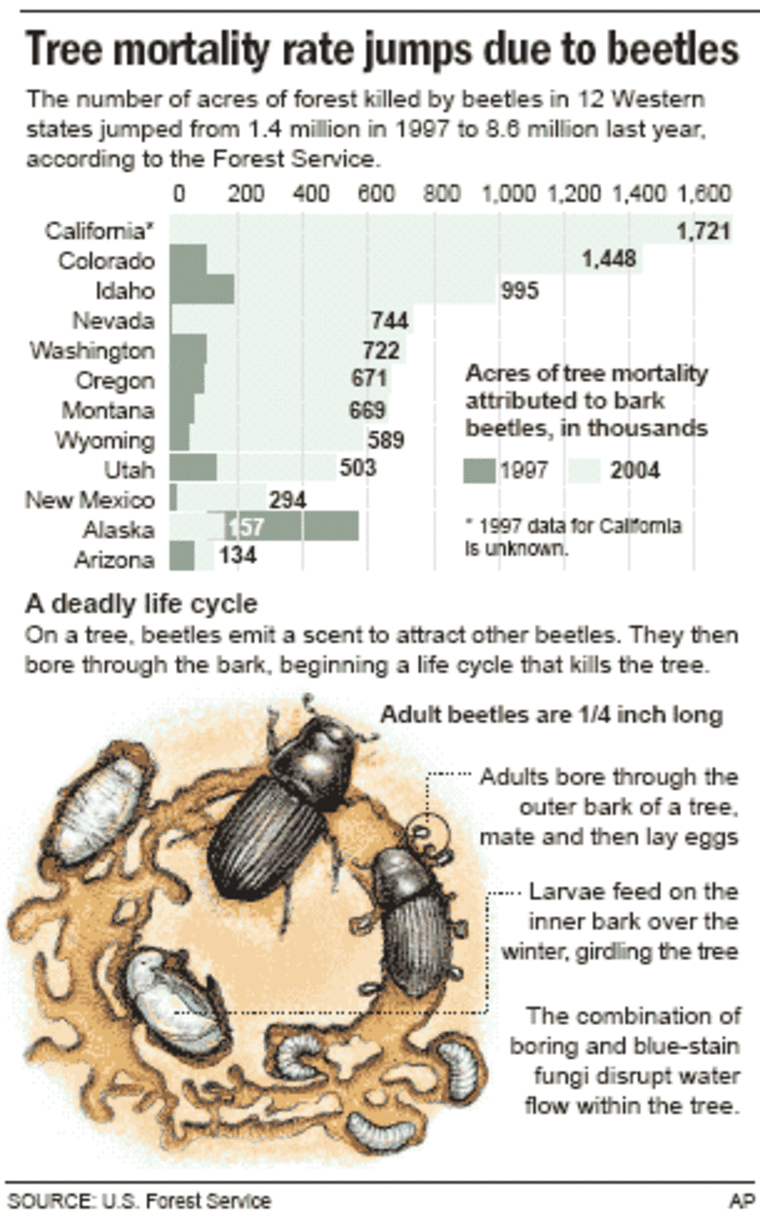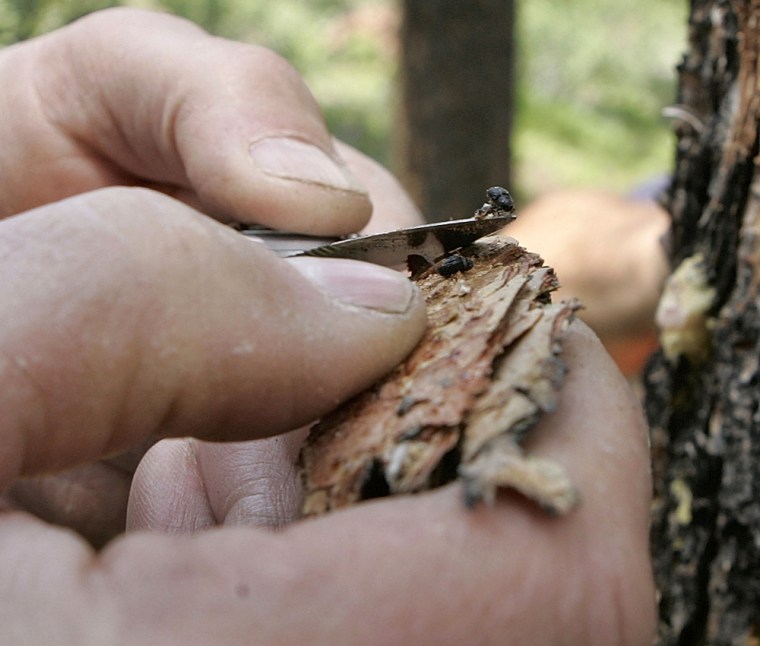The mountain views along Red Stone Road suggest early autumn, with splashes of red, orange and rusty brown dotting the green hillsides above the homes and condominiums of this Colorado resort town.
But this is summer and the colors represent dead pine needles on hundreds of pine trees that have been killed by beetles.
The tree mortality rate around Vail is striking, but it’s even worse in other parts of the West. According to U.S. Forest Service figures compiled for The Associated Press, the acres of forest killed by beetles in 12 Western states jumped from 1.4 million in 1997 to 8.6 million last year. And beetles also are making a comeback in the South, where they chewed up millions of acres of trees several years ago.
Beetle outbreaks come in cycles and are determined in part by drought conditions and overall forest health. The extent of the West’s current outbreak, however, has many people worried as the dead trees dry out and begin to fall, creating a canopy that can cause long, intense wildfires.
“As the trees die and the dead needles stay on the tree, those needles ignite much more readily than the green trees do,” said Paul Broyles, national fire operations program leader for the National Park Service in Boise, Idaho.
The Forest Service has removed some beetle-infested trees across the West in an effort to reduce the fire danger. In this posh resort area, the effort involves officials from the town, Vail Resorts Inc., the Forest Service and others. The goal is to protect homes, property values and, if possible, the view.
Burrowing in the bark
A few hundred feet off Red Stone Road, Cal Wettstein and Cary Green of the White River National Forest spot a lodgepole pine that looks perfectly healthy to the untrained eye. But there are telltale signs of a deadly infestation: Yellow, chicken pox-like spots on the trunk and little piles of sawdust at the base.

The two men cut off a layer of brown bark, exposing pores that have become the home of beetle larvae. There is a blue fungus left behind by the insects as they burrow under the bark, depriving the pine of moisture and nutrients it needs to survive.
Wettstein pries out an adult beetle with his knife and holds it up to the light. It’s no bigger than an ant and appears harmless. But thousands of beetles can attack a single tree, with each female capable of laying dozens of eggs under the bark. After they hatch, the insects stay hidden until the following summer, when they emerge and pick up where their parents left off.
“These are very small organisms that can pack a big punch,” said Scott Hoffman Black, executive director of the Xerces Society for Invertebrate Conservation in Portland, Ore.
The southern pine beetle population grew to epidemic proportions in the Southeast in 2000 and was partly responsible for wildfires that burned more than 400,000 acres in Florida, said Kier Klepzig, an entomologist with the Forest Service’s Southern Research Station in Pineville, La.
Not just Western problem
In 2002, about 13 million acres of trees were killed by the bugs; a year later, that number dropped inexplicably to 2.4 million acres. The populations are climbing yet again, though, with Mississippi and Alabama already reporting outbreak status. The beetles have also been spotted as far north as Ohio and New Jersey.
“The rest of the states are just waiting for another outbreak,” Klepzig said, adding that dead trees in the humid South are also prime fire fuel. “It’s not the typical dry-as-a-bone, tinderbox type of image, but the trees here burn just like the others in the West.”
Many experts say there is no practical way to reduce beetle numbers. Spraying insecticide is too expensive, and performing prescribed burns in hot, dry conditions is too risky.
“Over the past 100 years, everyone has done everything they can to prevent the beetle activity,” said Matthew Koehler, director of the Native Forest Network, a conservation group based in Missoula, Mont. “People have cleared a mountainside, others have even used dynamite. And in the end, they didn’t work.”
Diversity issue?
Black, an entomologist and ecologist, said having a diverse array of trees in the forest will cut down on the number of bark beetles, as they are species-specific to each kind of pine. For instance, mountain pine beetles attack a variety of pines, like the lodgepole and ponderosa, but they aren’t interested in Douglas firs.
Black said logging is partly to blame for the uniform forests in the West and for destroying potential nesting areas for woodpeckers, a natural enemy of the beetles.
“There’s less tree diversity, less diversity in size and age, and that’s allowed the beetles to spread easily in large areas,” he said.
